CyberGrip
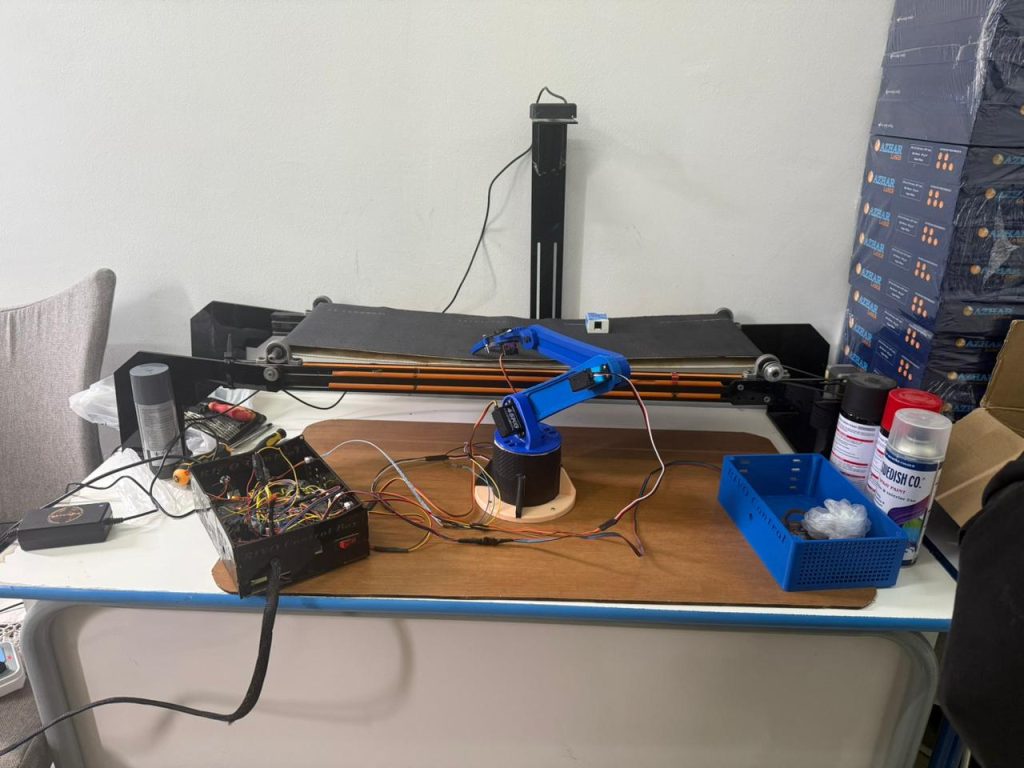
Our robot hand is designed for manufacturing and sorts materials by type using hand movement control. To support sustainability, we added energy-saving software, biodegradable 3D-printed parts, and a smart system that reduces power use during idle time.
Smart Farm
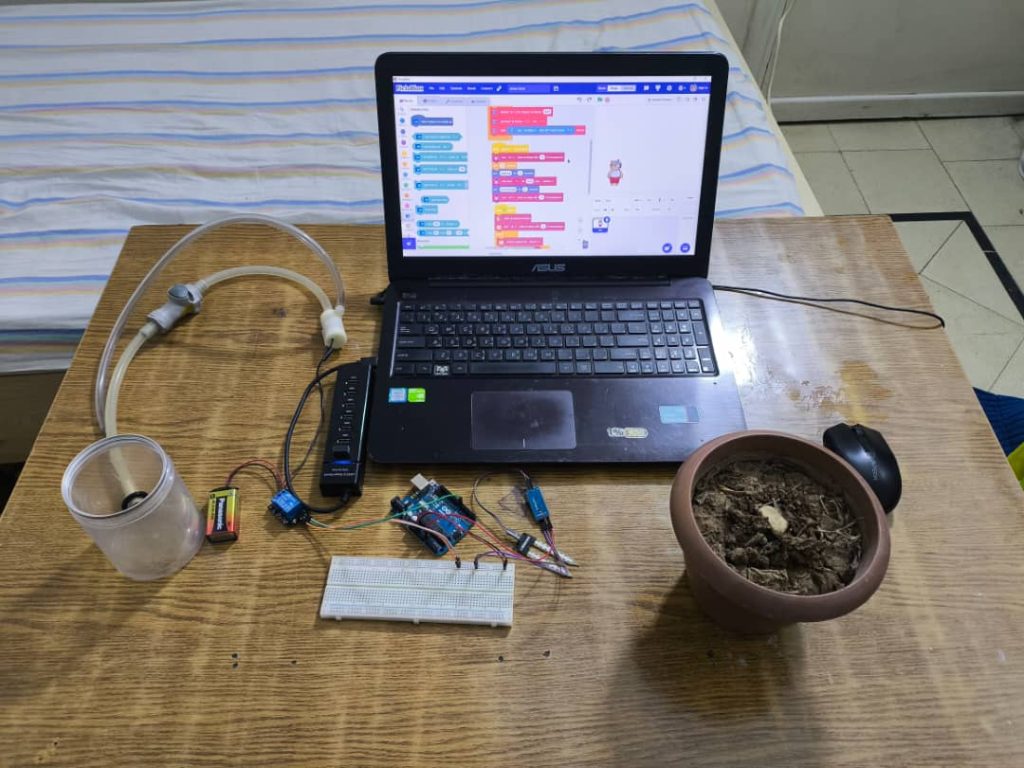
What do we have in our smart farm?
1. Smart scarecrow:
Most farmers suffer from birds that eat seeds and destroy crops, and some of these birds have become so bold that they are not afraid of the common scarecrow.
That’s why we designed a program using Object Detection library to create a smart scarecrow that, when it sees any type of bird in front of it, emits an alarm sound that is sufficient to repel these annoying birds immediately before they cause any problems.
2.Smart watering:
On average, farms around the world account for 70% of all water that is consumed annually. Of that 70% used by farmers, 40% is lost to the environment due to poor irrigation systems, evaporation, and overall poor water management.
So we easily solved this problem by inventing a robot with Arduino that waters the soil whenever it needs without any efforts.
3.Smart harvesting:
We think farmers are tired of harvesting their crops by hand and distinguishing between ripe and unripe fruits.
So we decided to create a program with Machine Learning environment that does this mission instead of the farmer and saves time and money.
4.Smart lock
Many thieves try to break into your farm and steal your crops?
With the smart lock on your farm’s door that detects your face using Face Detection library, no one but you can enter your farm any more.
The AI made farming a pretty simple job.
Smart Glasses for Blinds
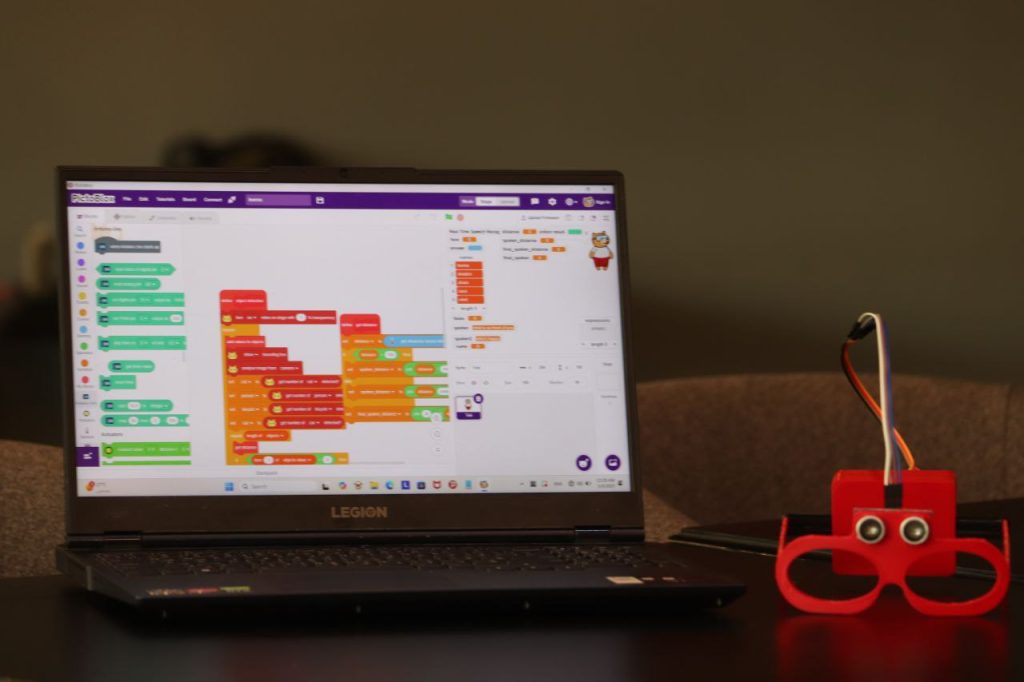
Our project:
Our AI glasses is an innovative project designed to support visually impaired individuals in navigating their daily lives safely and independently. Created by a dedicated team of three 6th-grade students from Damascus, Syria, these smart glasses combine modern artificial intelligence technologies to provide real-time assistance.
The glasses offer four essential features. First, they monitor the distance between the user and nearby obstacles using ultrasonic sensors, helping prevent collisions and ensuring safer movement. Second, the glasses can recognize paper currency, allowing users to handle financial transactions confidently without external assistance. Third, the glasses includes a facial recognition feature that identifies stored (saved) faces of family members and friends, helping users recognize the people around them. Finally, the glasses can detect and identify common objects in front of the user, providing clear audio feedback to help them understand their surroundings.
By combining affordable hardware with advanced AI models, the glasses makes assistive technology more accessible. The system uses a camera module for capturing images, lightweight AI models for fast processing, and audio output for delivering real-time information to the user.
Our goal is to make life easier and safer for visually impaired people through technology, and we believe our AI-glasses is a big step toward that future.
SecondBite
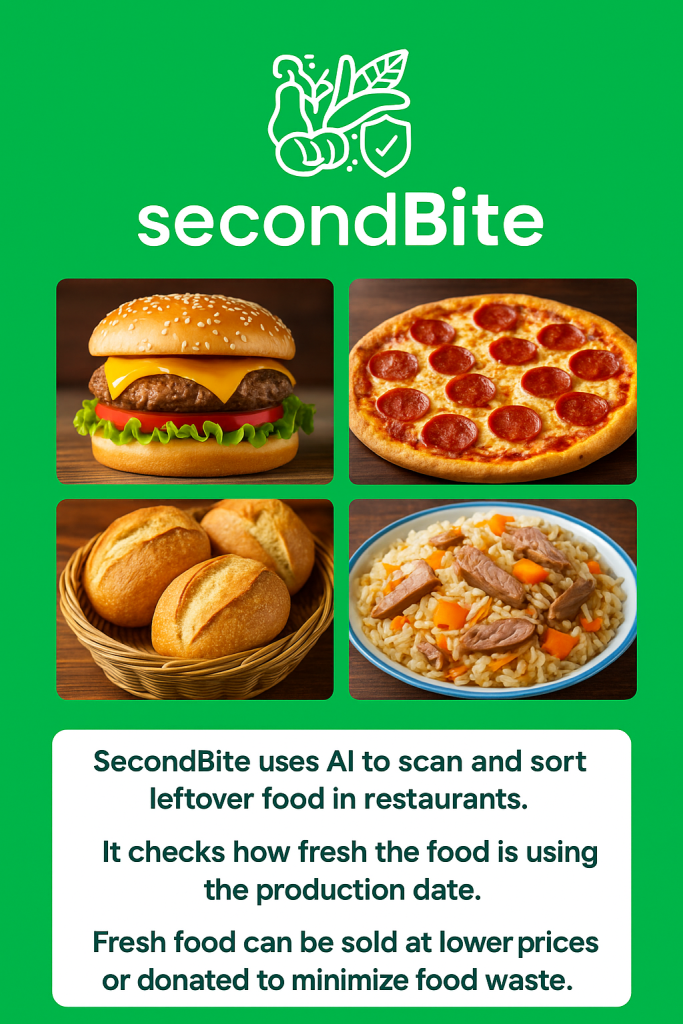
SecondBite transforms the way restaurants handle surplus food by combining computer vision, AI-driven shelf-life prediction, and streamlined distribution. At its core is an image-classifier model that instantly recognizes 13 categories—from grains, proteins, and dairy to fast foods like burgers and pizza—using a simple webcam snapshot. Once the food type is identified, staff enter its production date in a standard YYYY-MM-DD format. SecondBite then consults a lightweight AI agent (via a ChatGPT extension) to predict how many days the item will remain fresh under typical storage conditions. This prediction, together with predefined safety thresholds for each food group, determines whether the item is still “Fresh” or has “Expired.”
If the item is fresh, SecondBite calculates a discounted price—typically 50% off the original—and presents the restaurant with two clear, one-click options: put it on sale at the reduced rate or mark it for donation. A built-in database logs every decision, generating real-time inventory reports and sustainability metrics. Managers can instantly see how many meals were saved, total revenue generated from discounted sales, and the aggregate environmental impact in terms of food waste prevented and corresponding CO₂ emissions avoided.
By automating classification, shelf-life calculation, pricing, and distribution, SecondBite not only helps restaurants recoup lost revenue but also advances key Sustainable Development Goals—Zero Hunger (SDG 2), Responsible Consumption (SDG 12), and Climate Action (SDG 13). It’s a practical, scalable solution that turns today’s leftover meals into tomorrow’s community benefits.
Eco Guard
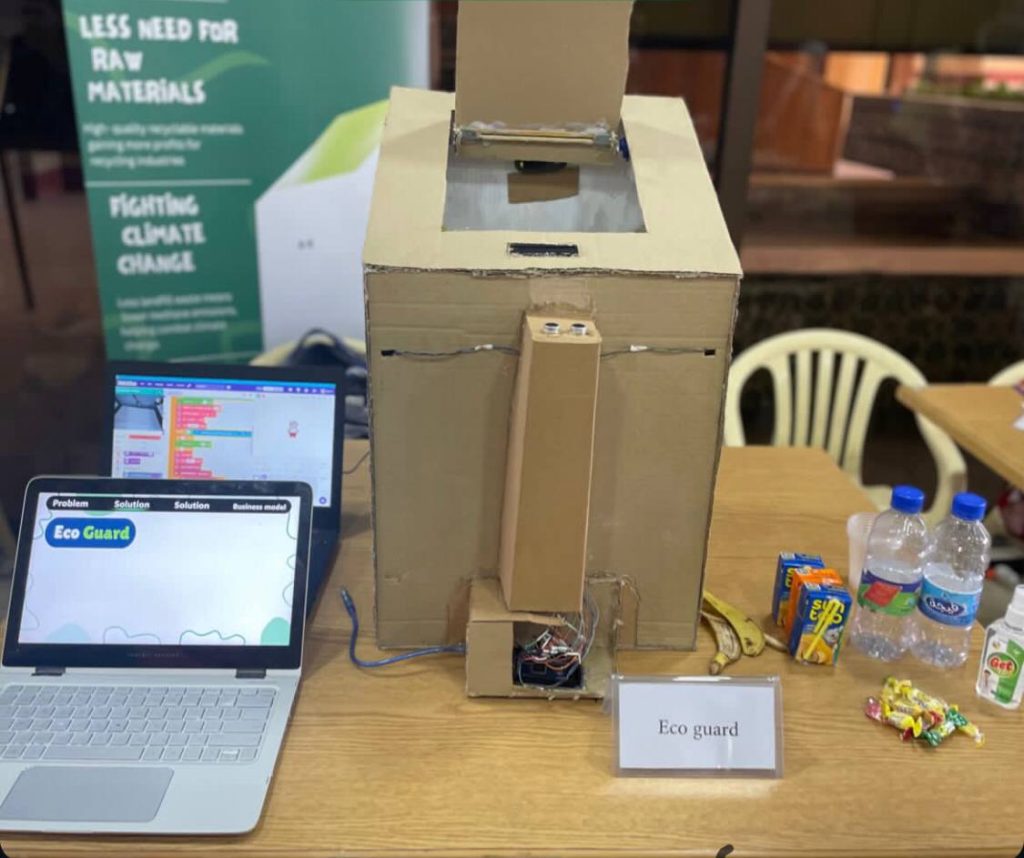
Eco Guard is an AI smart sorting bin that sorts waste into 2 compartments. Eco Guard uses ai and machine learning to recognize and sort trash. The AI model is trained with over 20,000 photos. Eco Guard has 3 sizes.
1- Personal sized bins that sorts into 2 compartments and is the smallest in size out of our 3 sizes.
2- Business sized bins that sorts into 4 compartments and is suitable for companies.
3- Public sized bins for outdoor that also sorts into 4 compartments and is weatherproof.
Eco Guard has a failure rate of 3-8% and it is just a prototype. Eco Guard has an automatic lid opening feature with automatic sorting powered by AI. Eco Guard has an auto full bin detection to avoid over-flowing problems, then it sends a notification to the nearest person (home owner, mall staff, employees, janitor,etc).
THE PARALYSIS CAR
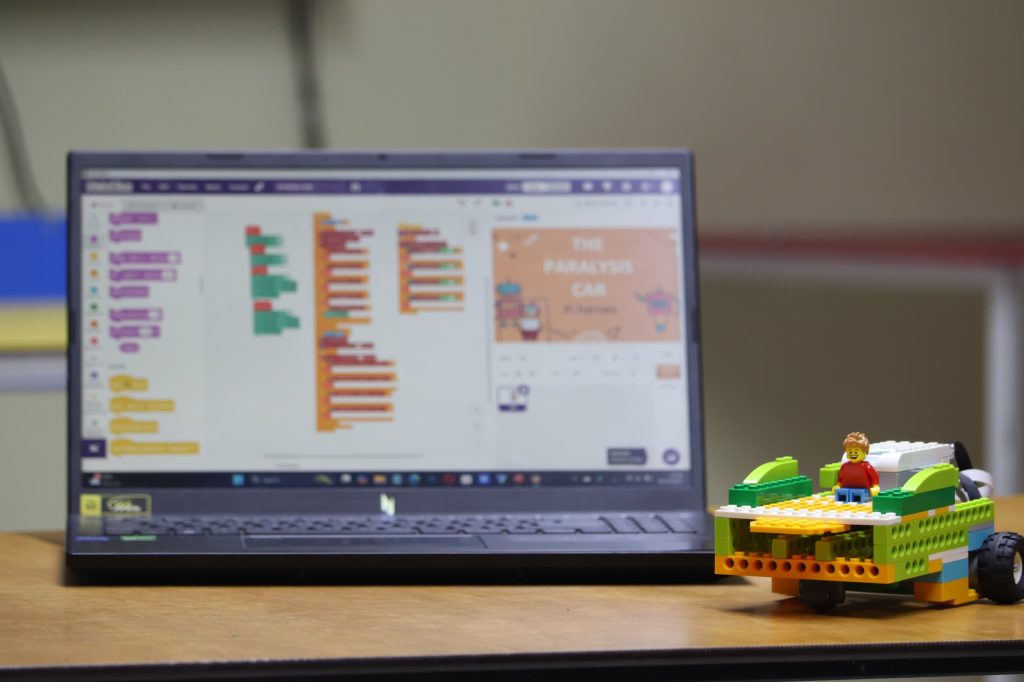
“THE PARALYSIS CAR” is an innovative project designed to empower individuals with physical disabilities, especially those with limited hand movement, by enabling them to control a small robotic car using only head movements. Initially, the team experimented with hand gesture controls but soon realized that some users—especially those with severe paralysis—could not rely on hand movement. This challenge inspired a shift toward using head tilts as the primary control mechanism.
The system integrates Pictoblox, LEGO WeDo, and Teachable Machine to recognize specific head tilts—left, right, and forward— backward and convert them into movement commands for the car. A webcam captures these movements, and machine learning models process them in real time, allowing quick and responsive control.
This solution offers a new way for people with paralysis to interact with technology and improve their mobility without traditional input devices like joysticks or remotes. The project was developed with a focus on accessibility, affordability, and simplicity, making it ideal for both educational and real-world applications.
Beyond its technical value, “THE PARALYSIS CAR” aligns with the United Nations’ Sustainable Development Goals, particularly:
Goal 3: Good Health and Well-being
Goal 9: Industry, Innovation, and Infrastructure
Goal 10: Reduced Inequalities
By combining artificial intelligence with empathy-driven design, the project demonstrates how technology can evolve to break barriers and create a more inclusive future……
Regenerative Oceanic Farming
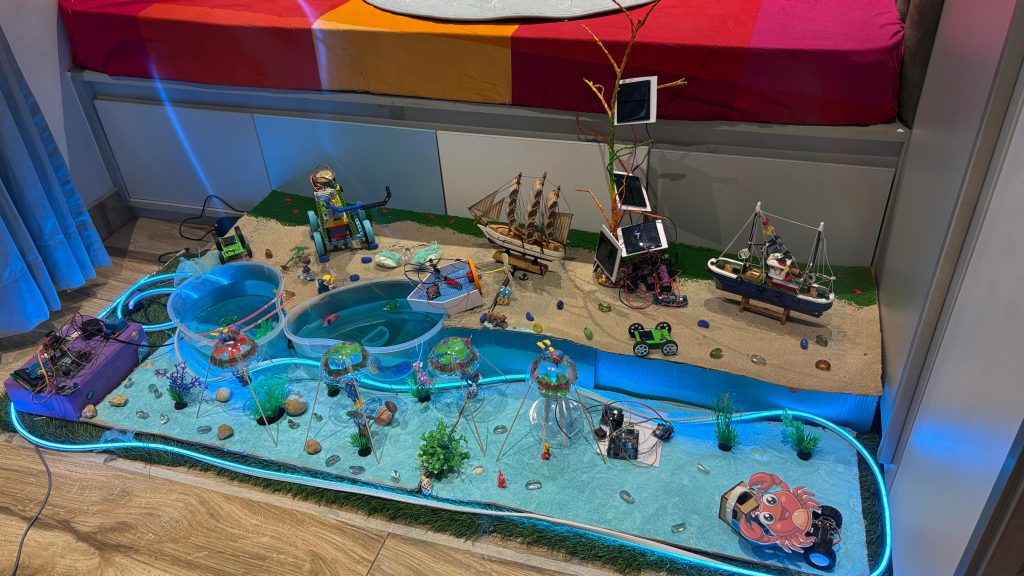
website: https://sites.google.com/view/rocsustainablity/home
In a world facing climate change, food insecurity, and ocean pollution, Team ROBO_WIZARD brings a wave of hope with the Regenerative Oceanic Farming — a futuristic blend of technology, sustainability, and marine science.
Inspired by Nemo’s Garden and Sadguru’s Isha Foundation SAVE SOIL movement, this project reimagines underwater farming using AI, sensors, and renewable energy. I designed a smart, self-sustaining underwater seaweed and seashell farming along with biodome that grows edible plants creating a new frontier for agriculture beneath the sea.
🌱 Key Innovations
• AI-Powered Fish Recognition & Ocean Waste Detection
Using PictoBlox’s AI models, our system identifies different fish species and detects marine debris, helping protect biodiversity and reduce ocean pollution.
• Smart Ocean Monitoring with Arduino Uno
Equipped with temperature and turbidity sensors, our farm monitors water health in real time, ensuring optimal conditions for plant and aquatic life.
• Underwater Farming Made Easy
A gesture-controlled robotic crane allows remote harvesting of seaweed and shellfish, while a nutrition delivery rover ensures plants are fed properly — all powered by an eco-friendly solar tree.
• Aeration and Humidity Control
A mini fan inside the dome balances humidity for plant growth, while a solar-powered aerator boat enriches ocean water with oxygen, helping nearby marine life thrive.
⚙️ Technology Stack
• Arduino Nano: Controls sensors, actuators, and logic
• PictoBlox: AI integration, gesture control, and sensor programming
• Sensors: Temperature, turbidity, humidity
• Actuators: Servo motors, mini water pump, fan, buzzer, LEDs
• Power Source: Solar panels and battery pack
• AI Models: Fish detection, ocean waste recognition, hand gesture control
🌍 Impact
This project aligns with the UN’s Sustainable Development Goals:
✅ SDG 13: Climate Action
✅ SDG 14: Life Below Water
✅ SDG 11: Sustainable Cities and Communities
Through our regenerative farming system, i aim to:
• Fight marine pollution
• Support clean food production
• Promote underwater biodiversity
• Use AI and robotics to protect our planet
👩🔬👨🔬 Why This Project Matters
With the world’s population growing and land becoming scarce, the future of farming lies underwater. Our system shows how young minds can use science and compassion to design solutions that heal the Earth — one smart farm at a time.
Smart Soil
Smart Soil is an AI-powered smart irrigation system designed to optimize water usage and improve agricultural productivity. The solution is divided into two main components: a mobile robot and a fixed water treatment unit. The mobile robot roams the farmland, equipped with an ESP32-CAM to capture real-time images of crops. These images are analyzed using PictoBlox AI to identify plant type, detect diseases, and recognize water-stressed plants, allowing timely irrigation and intervention. The robot also plants sensors in the soil to measure moisture, temperature, and pH levels. The fixed unit addresses water scarcity by filtering unclean water using a multi-stage purification system, making it safe for irrigation. All data is integrated into a centralized web and mobile platform, where farmers can monitor sensor readings, receive alerts, and remotely control water pumps. Smart Soil is a scalable, cost-effective solution aimed at supporting sustainable agriculture and combating the impacts of water shortages caused by climate change and infrastructure challenges.
Project Aswad
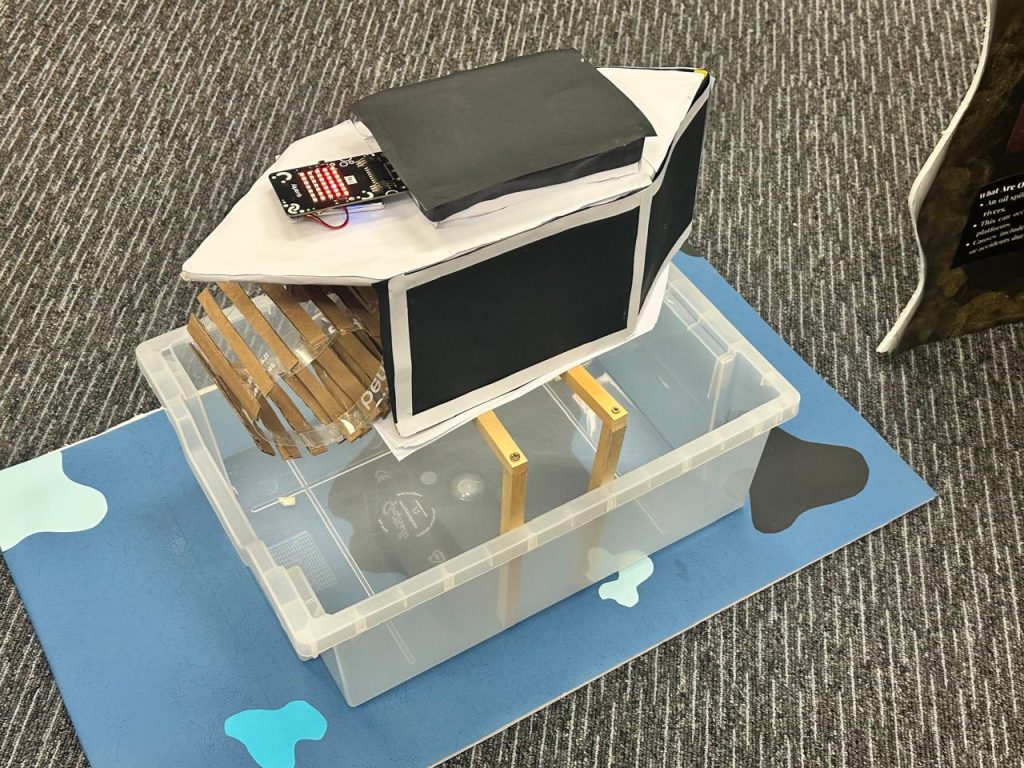
Oil Spills are environmental disasters, harming marine life and coastal communities. Traditional cleanups such as chemical dispersants, skimming etc are slow, inefficient and costly. To tackle this we have come up with- Project Aswad! It is an AI powered catamaran that detects, contains and cleans up the oil spill in a faster, smarter and more sustainable manner.
How it works-
Government’s satellite intelligence: Locate oil spills in real time and inform authorities.
Oil Detection: Once the sensors (color sensor, infrared thermal cameras and an ultrasonic sensor) detect the oil, the AI system neural network analyzes the real time data from the sensors.
Conveyor belt + Oleo Sponges: The conveyor belt lined with oleo sponges (absorb oil but repel water) is dispatched into the sea
Hydraulic compressor: oil collected by the oleo sponges is compressed. This oil is put into barrels present onboard. The oleo sponges can be used over 100+ times and absorb up to 90% their own weightThe oil collected can be later refined and used as per normal.
Impact-
Cost efficient- Cuts operating costs by 70%
Innovative- using recent developments in sensors and a machine learning AI system)
Eco friendly- clean up method does not affect ecosystem as no chemicals used
Scalable- catamarans can be deployed depending on size of spill
Developed with a marine scientist (Mr Oliver Farrel) from NYU Abu Dhabi, Project Aswad is a student made innovation to revolutionize how oil spills are cleaned. We aren’t just picking up oil- we are saving ecosystems.
PROJECT ZIRA
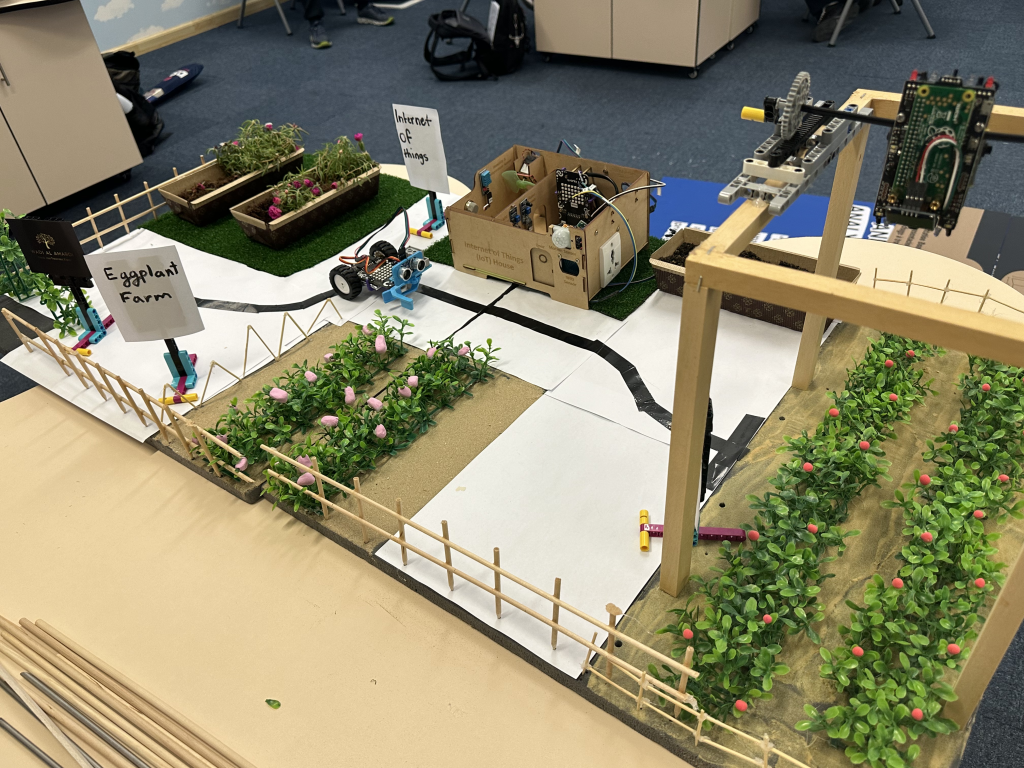
Project Ziraa is an innovative agricultural automation solution, responding to critical global challenges in farming such as labor shortages, crop loss from pests, and the impacts of climate change. Agriculture today faces huge challenges: up to 40% of global crops are lost to undetected pests. In 2024 alone, the U.S. needed 2.4 million more farm workers. Project Ziraa aims to modernize agriculture using AI and IoT technologies. We developed a system that makes farming smarter, more efficient, and sustainable – especially for small to mid-sized farms.
Ziraa’s components include:
Smart Farming Module: IoT sensors monitor soil moisture, pH, temperature, humidity, and light in real time.
AgroPilot: An autonomous robot that ploughs, seeds, weeds, and fertilizes.
Plant Doctor: A machine learning tool (using the KNN algorithm) that detects early signs of pests and diseases.
Fruit Picking Bot: Uses AI and robotic arms to harvest fruits without damage.
Quality Checking Bot: Sorts fruit by size, color, and defects with AI-powered vision.
Ziraa stands out because it integrates multiple features into a single, affordable system. It reduces water use by up to 30% and increases crop yields by 18%, while also lowering farming costs – offering long-term savings compared to traditional methods.
By combining technology and agriculture, Ziraa empowers farmers, protects crops, and secures the future of food production.
